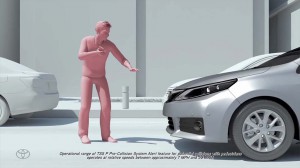Toyota and its luxury brand, Lexus, plan to make automatic emergency braking, or AEB, standard equipment on virtually all models and trim levels by the end 2017. That move would come five years ahead of the industry-wide rollout agreed to by a consortium of automakers earlier this month.
The technology is designed to recognize potential collisions and sound a warning to alert the driver. If there’s no immediate response, the system will apply the brakes automatically to avoid the crash or, at the least, reduce its severity. A recent study by the Insurance Institute for Highway Safety, or IIHS, found AEV can prevent up to 40% of police-reported rear-end collisions.
“High-level driver assist technologies can do more than help protect people in the event of a crash; they can help prevent some crashes from ever happening in the first place,” said Jim Lentz, CEO of Toyota Motor North America. “We are proud to help lead this industry in standardizing these systems and bring automated braking to our customers sooner rather than later.”
Toyota already offers both AEB and less advanced Forward Collision Warning, or FCW, technologies as a standard feature on a handful of models, mostly high-end Lexus products, while it is available as an option on other models.
The auto industry, as a whole, has been rolling out FCW and AEB technologies on a rapidly expanding array of products over the last several years, backed by data showing how effective it can be at preventing crashes and injuries.

Toyota demonstrated a more advanced version of automatic emergency braking available on Toyota and Lexus vehicles.
(Twenty automakers commit to standardized braking by 2022. For more, Click Here.)
AEB relies on a mix of sensor technologies, including laser, radar and artificial vision, components that also can be used for other advanced vehicle safety functions, such as active cruise control – which allows a vehicle to automatically follow the flow of traffic without a driver’s intervention.
The most basic auto-brake systems are designed to spot cars and other large obstacles. More advanced versions can detect pedestrians and even animals crossing the street.
An extensive study by the IIHS found that forward-collision warning systems can prevent more than 20% of collisions, while the more advanced AEB can almost double that effectiveness.
That life-saving potential led to the formation of a precedent-setting industry-government consortium last September. The group – which included Toyota and 19 other automakers, as well as the National Highway Traffic Safety Administration – last week announced members had agreed to make AEB standard on 99% of the vehicles sold in the U.S. by 2022.
(Click Here for details about FBI’s warning about increased vulnerability of cars to be hacked.)
“By proactively making emergency braking systems standard equipment on their vehicles, these 20 automakers will help prevent thousands of crashes and save lives,” Transportation Secretary Anthony Foxx during a Washington, D.C. news conference last Thursday. “It’s a win for safety and a win for consumers.”
Other automakers, especially Lexus competitors in the luxury segment, are expected to also make auto-braking standard ahead of the 2022 target, according to comments made by several industry executives and analysts.
Still more advanced forms of the technology are under development. More AEB versions are expected to increase their capabilities to include pedestrians, motorcyclists and animals. Meanwhile, the next big breakthrough is expected to allow vehicles to not just stop to avoid an obstacle but actually steer out of harm’s way, said Jeremy Carlson, a senior analyst with IHS Automotive.
That advancement, he noted, would give the driver “the chance to avoid an accident you might only have been able to mitigate before.”
(To see more about what U.S. cities lead the nation in traffic congestion, Click Here.)
That next step in auto-braking technology is expected to be on the road on a limited number of models by 2017.

